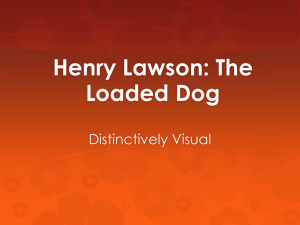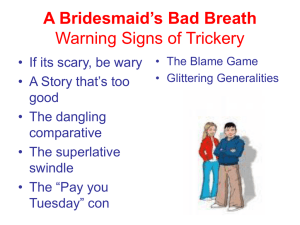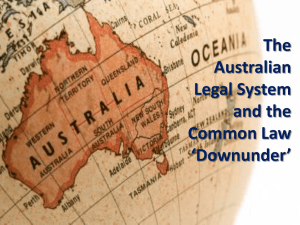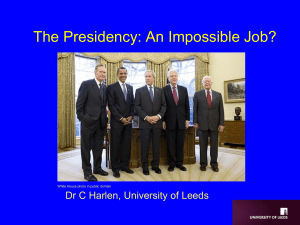Part III Australian Culture
advertisement
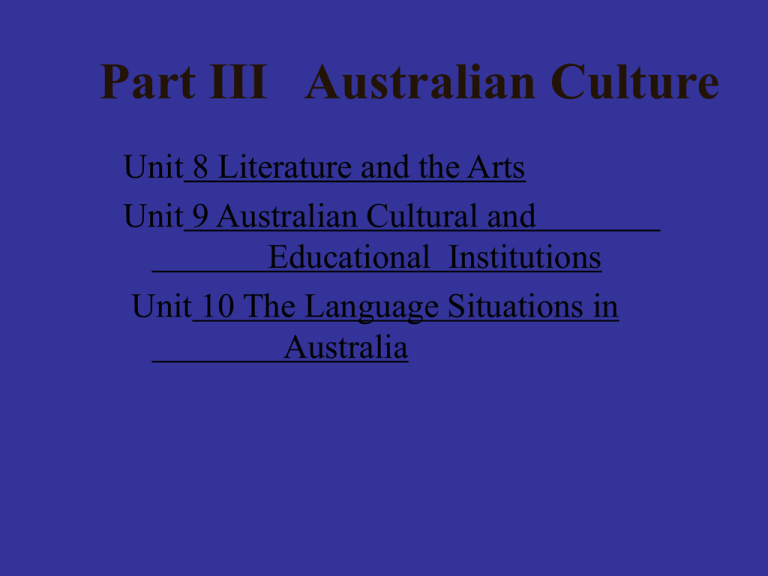
Part III Australian Culture Unit 8 Literature and the Arts Unit 9 Australian Cultural and Educational Institutions Unit 10 The Language Situations in Australia Definition of Culture The totality of socially transmitted behavior patterns, arts, beliefs, institutions, and all other products of human work and thought. These patterns, traits, and products considered as the expression of a particular period, class, community, or population: Unit 8 Literature and the Arts • • • • • Introduction Australian Spaces: The Land What Now? Conclusion Questions for Discussion Introduction This chapter explores the themes of land and sense of place for Australian writers and artistes. Despite the fact that Australian has been a predominantly urban society since at least the turn of the last century, Australian writers and artists have long been preoccupied with the bush. Both those who live here and those overseas who imagine Australia think of wide open spaces, the desert, inland, the beaches, the bush and outback. Many of the best known images of Australia are non-urban. We will explore how themes of the bush are represented in the work of immigrants and Indigenous Australians, past and present. Reading about the Representative Bushranger Ned Kelly (147- 48) Australian Spaces: The Land • • • • The Bush The Bush Myth The Legend of the Bushman Mateship The Bush • It would be hard to over-estimate the importance of the land, especially ‘the bush’, in Australian literary culture. From the nineteenth century onwards, the bush has been used to define Australia’s difference and distinctiveness. But the ‘bush’ is a myth, not only because most Australians live in cities, bush also because many different meanings and values have been attributed to the bush over time. Further, many different kinds of nonurban landscapes have been referred to as ‘the bush’. In other words, the meaning of ‘the bush’ has changed as Australia’s culture and society have changed and as people’s sense of where the ‘real Australia’ is to be found has altered. The Bush Myth • The bush appears as a desirable vision in the daydreams of a man trapped in the city office. This utopian representation of the bush as a free, natural space in contrast with the drudgery and ordinariness of city life can also be found in the contemporary films and television series, as well as advertising. This dream— often called the bush myth—is central to definitions of Australian identity. This is how ‘Australia’ is most commonly represented, both at home and abroad. The Legend of the Bushman In the city/bush binary, city men are constructed as being as than men, ineffectual. The bushman, by contrast, is independent, authoritative, powerful and competent. The isolation of the bush led to a real need for a sense of solidarity. A sense of community developed based on a mutual dependency. There were few women in the bush and men kept company with each other. At the same time, male solidarity was accompanied by a degree of competitiveness and aggression towards each other. As the bush became more settled, it was increasingly domesticated. There were more women, families and also ‘small men’-men from the town, men with white-collar jobs. Mateship This is a very important concept in male working class solidarity – as a form of resistance against landowners, police, and all figures of authority, including the 'squattocracy' or 'bush aristocracy' that developed in the country. Within this was a distaste for the manners and sophisticated ways of urban people, who were seen as physically weaker and inferior to the rugged manliness of rural people. Foreigners were also outside this solidarity; recent arrivals were seen as inferior to those bush people born and bred in Australia. There was also antagonism against the Chinese in 1850s/60s and towards Aboriginal Australians (ref p. 170). In other words, almost everybody was seen as an enemy, or inferior, to the bush man. This included women, who were seen as the enemy of man's freedom - as the domesticating influence, as agents of entrapment. Note, however, the conflict between mateship and individualism. The gang is a hierarchy, but can only survive through mateship. It's a solidarity that is informed by the gang's sense of itself as a minority group - an ‘us against them' solidarity. What Now? • This section explores the meanings of Australia being a ‘multicultural’nation in contemporary writing. Indigenous Australians do not think of themselves as part of the multicultural nation, being the only non-migrants to this land. Some Aboriginal writing is introduced in the following reading materials (151-57). We then explore the writing of postwar migrants, largely from European backgrounds, and of more recent migrants, largely from Asia. Conclusion • Now, modern artistes have an attempt to depict the kind of mix and complexity of identity in contemporary Australia which Castro is advocating as ‘hybridity’. Questions for Discussion • Can you suggest why the natural environment --the land, the bush,etc.---has played such an important role in Australian writing and visual art? • What themes and issues have featured in contemporary Indigenous writing? • In what ways do you think Australian literature has developed differently from British of American literature? • Discuss in your own words Brian Castro’s idea of ‘hybridity’. Unit 9 Australian Cultural and Punitive Institution • Introduction • The Courts and the Rule of Law • Two Cases Introduction • In this chapter, we explore the law as both a cultural and a punitive institution, because it has both there meanings in the common law tradition inherited from Britain. The Courts and the Rule of Law • The Common Law Modern Australia is a common-law country. Its British origins as a settler society made it so. There are two types of ‘judges’ in the early colonies. District Court and Supreme Court judges were appointed to decide serious matters in the criminal and civil jurisdictions. The magistrates dealt with minor criminal offences and civil matters in the Courts of Petty Sessions held in many settlements. • The Court Houses In Australia, it is sometimes said, the law courts express the moral and ethical beliefs. Almost everyone is likely to meet the ‘law’ during their lives. Two cases • These two cases, one historic and one contemporary, give some flavor of the role of law in Australian lives: • Ned Kelly, the Bushranger---a Criminal Trial (207-08) • Mabo --- a Civil Case (208-09) Unit 10 The Language Situations in Australia • • • • Introduction Indigenous Language Australia English Conclusion Introduction • Many people overseas, including some Chinese, take it for granted that Australian is a monolingual country, where most of the inhabitants speak English. This is true only partly. Although English is the dominant language spoken by the majority of Australians, it is by no means the only language used in Australian society. Australia is, in fact, one of the most multilingual societies in the world. Indigenous Language • Indigenous languages refer to language used by Aboriginal Australians. Terms like Aboriginal languages, native languages and Australian languages are also used with the same reference although the last term may be a little misleading because it does not include either the different verities of Australian English or community languages spoken mostly by migrant Australians. • As a language group, they are characterized by a number of noticeable features and numerous and diverse. These native languages are highly developed instruments of communication and culture. They each possess a wide vocabulary and an intricacy of grammatical forms so that Aboriginal Australians are enabled to express the subtleties of meaning in any aspect of their social life from complicated myths to detailed and precise information about their everyday activities and the landscape. Besides, these languages also serve to mirror the social life of Aboriginal Australians and signify the ethic identity of the Aboriginal population as a whole. Australia English • Although Australian English has been the dominant language in the country, yet varieties of Australian English have emerged over the time of linguistic development. This has had much diversity of the country’s ethic composition. Roughly speaking, 3 varieties of Australian English can be distinguished which are Aboriginal English, migrant English and white Australian English. Conclusion • This general survey of the language situation in Australia demonstrates clearly the linguistic diversity, especially the ethnolinguistic diversity in country. • It is obvious that Australia is a multi-lingual society. It is, however, not only in the postwar period that the country has a multi-lingual situation, linguistic diversity existed, and in fact, thrived in some parts of Australia from the early days of European settlement. • The country has now adopted a more comprehensive and progressive policy on multilingualism than any comparable countries in the world. This paradox, monolingualism versus multilingualism, is characteristic of a tension that has existed throughout the history of white settlement between three symbolic relationships of language and society: English monolingualism as a symbol of British tradition, English monolingualism as a marker of Australia’s independent national identity, and multilingualism as both social reality and part of the ideology of multiculturalism. This tension dates back before the federation of six British colonies into an Australian nation in 1901, and has not been resolved (Cylne 1991).



